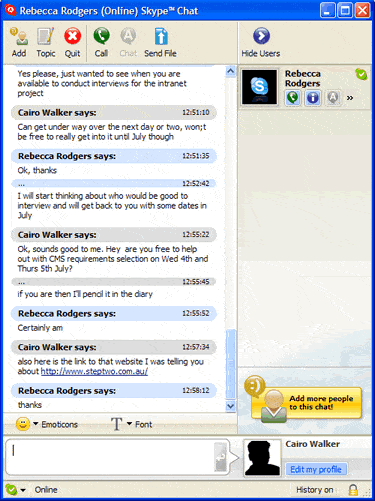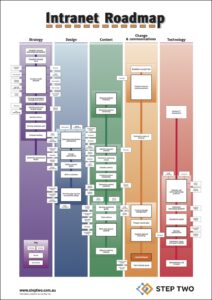
Filed under: Articles, Collaboration and social
No longer the antithesis of working hard, online chat has become an integral part of core business processes in some organisations.
Across both the public and private sectors there is a trend toward online chat as a valid business tool, particularly in call centre environments. By using online chat to supplement traditional information sources such as intranets and training folders, staff are provided with answers to specific problems and questions and access to specific staff in real-time.
Online chat can be used to:
- to leverage the collective knowledge resources and research capability of the team
- as a training and management tool
- to contact remote staff who are unable to respond to a phone call
- for staff socialisation.
This article explores the use of online chat in business and describes a case study of the use of instant messaging within a national enquiry centre for a government department that fields calls from the public across Australia.
What’s all the chatter about?
Online chat is a text-based communication tool. Whereas email is to an electronic version of sending letters through the post, online chat is more like having a conversation with one or more people. Information is passed in real time and users can see whether others are available to chat. By setting their status as ‘available’, ‘away’, ‘on a break’ etc, users signal their availability to others. It is relatively unobtrusive and, unlike a telephone call, users are not forced to respond immediately.
Online chat supports both one-to-one and one-to-many relationships and communities. Users can have several chat sessions going at one time with different individuals and groups. Typically within the call centre environment there is one team chat session that is open all day running alongside one-to-one sessions.
Leverage the collective knowledge of the team
Organisations threatened by chat
Instant messaging has its roots on the internet, making its way into the general population through programs such as AOL Instant Messenger, Microsoft’s MSN Messenger and Yahoo Messenger.
Instant messaging applications are low, or no-cost to organisations and often come bundled with other software already purchased. Even so, many organisations do not provide the opportunity for staff to access instant messaging applications for fear that it will be a time-waster, distracting staff from their core duties. This is a subject that has been much debated and any CIO forum where this is discussed demonstrates just how divided opinion on the matter is.
While some see instant messaging as a key communications tool, others view instant messaging as a time-waster, and even as a security risk. The latter issue is perhaps where attention should be focused as many organisations are now demonstrating the place of instant messaging alongside email and other communications tools.
The risk of misuse
Any tool that is used for communication is open to misuse, and instant messaging is no different. Perhaps because most people are introduced to chat informally across the internet it may not be approached by end-users and governance bodies with the same level of thought as other systems. Whilst this is certainly a consideration for organisations, familiarity is the very reason why instant messaging can be such a powerful tool as employees approach it with ease.
With its informal nature and mirror to the way humans actually converse with each other, it has been a natural favourite among staff.
Creating a permanent record
Unlike email, instant messaging appears ephemeral to users, largely because the sessions or threads disappear from the chat window at the end of the user’s working day. Users are presented with a clean window each time they open the application.
While it might appear to be gone, in fact a permanent record is created just as with email. Organisations must alert employees to this fact. The usual business protocols governing ‘acceptable use’ should be put in place to protect the individual user as well as the organisation as a whole.
Support one-to-one and one-to-many relationships
Reusing information
As with all systems, the creation of a permanent record does not ensure that information is available for re-use by staff and important pieces of information pass into obscurity each day. Many organisations avoid this by appointing a ‘gardener.’ This is a person whose job it is to monitor the conversations that are taking place, harvest the important pieces of information and then transplant them to an intranet or similar resource.
Most instant messaging applications provide the facility to save a chat session for later reference by participants. Although this may be useful to individuals it is difficult to share with a wider audience and searching through a proliferation of instant message streams to find the required information will be even more difficult than finding documents on network drives, databases or in email archives.
Security
Arguably instant messaging should be subject to the same level of control as other communications systems. Depending on how it is used within the organisation, retaining and archiving business records (beyond gardening) may be appropriate. Organisations are likely to align such decisions to current practices and policies and to the company culture.
Certainly other security precautions, such as keeping confidential data safe, shutting out viruses and spim, monitoring and blocking rogue content and clearing out unnecessary messages, should be taken.
Online chat mirrors the way humans interact
Living with risk
It is better for organisations to manage the risk (real or perceived) of employee abuse of the system and the security issues of instant messaging than it is to ignore it.
Governing groups should focus on managing this risk rather than using it as a reason to stay away from instant messaging. Organisations that have rushed to bring about a blanket ban on instant messaging have found that eager employees will find a way to ‘bring it in through the back door’.
Leveraging social networks
Many managers and decision makers have failed to grasp the gains that can be made by providing technologies which capitalise on already established social networks. Systems based on such networks are well-placed to expose business content and provide value to the organisation. Where instant messaging is concerned, the market is now well-established and user expectations are growing (along with demand). Organisations are coming under increased pressure to provide such capability to their staff.
In his article, ‘The read-write web’, Hans-Peter Brondmo talks about the participation age where ‘distinctions fade between creating and consuming, reading and writing, applications and mash-ups, centralized and distributed content’ and points to the need for a ‘new breed of tools and services that will facilitate easy, fun, and social content creation’.
Incorporating instant messaging and other read-and-write applications into any organisation will necessarily bring other issues of a more philosophical nature to the fore. Organisations will be forced to grapple over such questions as, ‘who will assume the authoritative stance in this read-and-write economy?’
Current models of defining value and business usefulness will not work and the challenge will be for organisations to recognise that ‘time-wasting’ is a management issue, not a technical or system-related one
Use by remote staff
Instant messaging is an extremely useful tool for staff who are working remotely from each other. By eliminating the inevitable lag in communication that comes with email and by profiling which users are online and available to chat at any given time, team members can target their questions to the person best placed to answer it. If a team member is not online at the time, text can still be sent. This will be delivered as an instant message next time they log on to their instant messenger or connect to a network.
Unlike other available communications tools, instant messaging allows staff to always feel connected to the rest of the team and helps to manage the sense of isolation and disconnectedness that can occur for teams working remotely from each other.

Learning the lingo
There are many different terms associated with instant messaging. As with many web technologies there is not always clear agreement on what each term means and there is certainly overlap between many of them. This list, though by no means definitive, provides an overview of the key terms and their definitions.
Instant messaging
Instant messaging is a form of real-time communication between two or more people based on typed text. The text is conveyed via computers connected over a network, either internally within an organisation or over the internet. Instant messaging, unlike some other forms of chat, requires that users are pre-loaded, that is, users are already known to each other.
Chat room
Chat rooms are usually set up and named to promote a particular subject. As with instant messaging everyone sees what everyone else has typed, though small groups can break off and engage in their own chat.
Online chat, chat or text-based chat
Online chat can refer to any kind of communication over the internet, however it is more usually refers to direct one-to-one chat or text-based group chat (formally also known as synchronous conferencing).
Chat session
This is the actual instant messaging session or sessions that are happening at any given time. Users typically refer to these as chat sessions.
SPIM
SPIM is like SPAM, however this type of SPAM targets instant message users. SPIM is not an issues when instant messaging is used internally in an organisation. Choosing to receive instant messages only from members of the contact list will eliminate this even when chatting on the internet.
SMS
This is text-based communication to a mobile phone from another mobile phone or other device such as a computer. Many instant messaging applications enable users to elect to send or have messages sent to their own or another user’s mobile phone.
Synchronous conferencing
This is a term used to describe computer-based collaboration. It is also used to describe audio/visual conferencing facility and instant messaging.
Status
Most online chat applications allow the user to set their availability status to be displayed to others when they are online. Typical settings are: available, away, on a break, offline, do not disturb.
Presence information or contact list
This is a list of contacts that are available. Presence information allows a user to see who is online and available for chat. It also enables individuals to mark themselves as unavailable, away, on a break etc. Many applications have facilities for users to update their profiles by adding pieces of information about themselves and creating an online image by adding a photograph of themself or creating an avatar.
Case Study: The National Enquiry Centre, Family Law Courts
The National Enquiry Centre (NEC) fields calls relating to family disputes from the general public and from legal advisors and administrators. These calls can come into the Sydney-based NEC from all states except Western Australia. The goal of the Family Law Courts is to facilitate the resolution of disputes arising from family separation.
Working closely with the registry staff (except in Western Australia), the NEC provides general information about the procedures of the Family Law Courts, its’ forms and publications, and refers callers onto the appropriate bodies for services outside the scope of the Family Law Courts. The NEC does not provide legal advice or interpret or enforce orders made by a judge. It does however form an essential conduit between the public, including legal professionals, and the court.
A difficult job
Understandably the role of the NEC staff is not an easy one as they are dealing with members of the general public who are facing a difficult and distressing time in their lives. Callers have little tolerance for misinformation or for waiting on the phone for any period of time. The information that the NEC draws upon to answer queries is vast, and ranges from the Family Law Courts intranet, various internet sites produced by external parties, Family Law Courts brochures and publications and a training manual that has 300+ pages.
Different information needs
The challenges for staff vary depending on the nature of the query and the length of their service with the Family Law Courts. The majority of calls fall into a key topic area such as divorce. Enquiries around divorce typically relate to ‘how do I get a divorce?’ including how much does it cost, what is the process and so on.
Long-serving staff members build knowledge
Longer serving staff members build up knowledge of the most frequently asked questions and processes. After answering a certain number of calls, or having been at the NEC for a long period of time, staff just ‘know’ the answer or way of doing something and there is no need for them to reference training or other materials.
Although new staff members undergo thorough training before they start taking calls, this training is intensive and there is a huge amount of information that must be assimilated in order to answer calls. The training manual is a rich resource, however it is far too dense to be used quickly as a reference tool by staff who are on a call.
The steepest learning curve for new staff occurs in the first six-month period. After this time staff members are able to respond to calls within the high-volume categories comfortably using the knowledge they have built up. The issue then is how to resource new starters appropriately?
Support new starters appropriately
Ready reckoners
‘Ready Reckoners’, ‘cheat sheets’ or ‘quick reference cards’ are a great way to provide high level information and reminders or prompts in a way that it can be quickly and easily accessed. Typically created in Excel or similar, ready reckoners feature in many call centre environments.
To provide an example of the information contained within this ‘page-to-a-view’ document, a ready reckoner for orders sought in relation to final parenting arrangements may include the following:
- which court the application can be made to
- the exact title of the procedure/ application
- the form number
- any restrictions on filing
- the number of days it is listed from
- any documents that must be filed with the application
- whether a subpoena or an affidavit is allowed
- any other relevant information
This information is presented in the context of the business process, in this case orders sought. Each row in the document contains information relating to other types of orders sought. This is important as there is a fine line between interim and final orders sought, for example.
As a resource for new staff, a ready reckoner is great, however it doesn’t address any question that falls outside this very narrow information set.
Chat helps with the unusual
New starters will certainly have other questions that they cannot answer and longer-serving staff will be seeking out answers to the more unusual questions received.
Within a call centre environment it is not always possible to ask the person next to you a question, as often everyone will be on a call.
To counter this the NEC has a group chat session running amongst the current shift throughout the day. Instant messaging is an unobtrusive mechanism that still manages to tap into the collective resources of the team. Sometimes answers are drawn from the knowledge and experience of others, who can answer directly. At other times an available team member will carry out research for someone who is on a call. More experienced team members will have a better understanding of the best place to research any given matter. This experience can also be drawn upon, along with their contacts and ‘go-to’ people.
Instant messaging is an unusual way of communicating for most organisations, and many managers doubt that it yields a quality end result. However, it is clear that drawing on the collective resources of the team enables quicker and more accurate answers.
Draw on the collective resources of the group
Pushing information out
Instant messaging can do more than pull in answers to unusual questions – it also provides a mechanism to push information out to the group. Information that has a very short life span is especially suited to this.
The NEC use their chat to share information in this way such as ‘I just had such and such a caller on the line, the call dropped out, please put them through to me if they call back’.
Chatting one-to-one
In addition to the group chat session that is open all day there are number of one-to-one sessions taking place at any given time. The nature of these varies greatly. Instant messaging can be used by the NEC supervisor to provide specific assistance to a team member on a call, or between peers because the staff member can see that another staff member dealt with the same case last week.
These one-to-one chat sessions typically run for a short time until the issue at hand is resolved.
Chatting remotely
One of the most important ways that instant messaging is deployed within the NEC is to contact their associates who are based at the many court houses across Australia. These staff members spend much of their time in the actual courtrooms and are not contactable by telephone for much of the day. Whilst they cannot take phone calls, their computers are with them, connected to the internet and they use them throughout the proceedings.
The instant messaging application will show the NEC staff member whether or not the specific person is online and available, and if not it will provide alternative contacts.
By using instant messaging the NEC is able to return an immediate answer to the caller, which can only serve to improve client satisfaction and reduce the need for call backs.
Provide a sense of community
Social chat
The final way that instant messaging is used by the NEC is as a way for staff to socialise throughout their working day.
Call centres are high-pressure environments with few other avenues for communication throughout the day, and online chat provides a social mechanism to keep operators connected to each other and foster a sense of community.
This social chat is a group session and typically centres on events that are happening for the team and sometimes for individuals within the team.
For example, each week the team has social events and these are discussed through online chat, Christmas party preparations are made and so on.
Individual achievements, both work and personal, are acknowledged along with birthdays and other anniversaries.
Staff are quick to embrace chat
The National Enquiry Centre summary
Online chat is a valid communication tool that has a specific purpose within the NEC. The role that online chat fulfils could not be filled using other communications mechanisms. The primary tools used by the team are as follows:
- client database for the management and reference of contacts
- intranet/ internet for reference, particularly in relation to referral information
- email as a general communication tool
- instant messaging to ask for, and retrieve answers to unusual questions, to make contact with remote staff who are often in court and as a socialisation mechanism
Other methods of recalling important pieces of information do not provide the rapid response that is key in the call centre environment. By leveraging the collective resources available, a prompt response is forthcoming and the team works on problem resolution together. The good social atmosphere of the team becomes part of ‘the way things are done around here’. Essentially it becomes part of the NEC culture.
Summary
While many organisations have viewed chat as a threat to productivity, users have been quick to embrace it. To date, internal online business environments have been a one-way street. Whilst this may have been acceptable in the past, the new generation of online consumers are growing up with a different set of expectations. It is no longer acceptable to merely push information at consumers, consumers want to reel information in as well. This fact has been long accepted, yet until now systems have been poor at doing this. Users want what they want when they want it, and by leveraging the collective power of any given group, online chat can provide tailored information at a nominal cost.
Rather than proving itself a time-waster, instant messaging is now showing itself to be a valid business tool in many organisations, particularly those that recognise the value of team socialisation and of the contribution that users have to make.
Care should be taken to protect both the organisation and the individuals within it from misuse of technology. Appropriate business rules and governance practices should be put in place.
In order to ensure that valuable information surfacing through chat is retained for re-use within the organisation, chat sessions should be ‘gardened’ and the appropriate content placed on a less ephemeral communications system such as an intranet.
Online chat is one of the few tools that allow staff to write as easily as they read. Because of this they are quick to embrace it and deployment within the right business processes will provide returns within any business.





